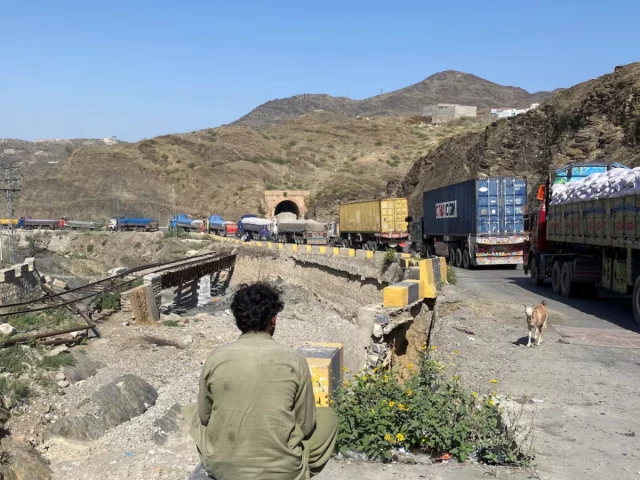A man sits next to trucks parked at the Torkham border crossing after Pakistan closed the border crossings with Afghanistan, following exchanges of fire between the forces of the two countries, in Torkham, Pakistan, October 12, 2025 Photo: Reuters
On Sunday morning, for the second time this year, we woke up to the news that Pakistan was at war again. This time it was with Afghanistan. Videos of Pakistani soldiers standing on top of Afghan border posts flying the Pakistani flag circulated on WhatsApp. Why did this happen?
Wasn’t our relationship with Afghanistan warming? We had agreed to a train from Peshawar to Kandahar, and for the first time in three years both countries had appointed ambassadors.
We got along so well that Pakistan and China said we would extend CPEC 2.0 to Afghanistan. Foreign Minister Ishaq Dar had just greeted the cameras with a big smile as he stood hand in hand with the Afghan and Chinese ministers in Kabul.
When a deadly earthquake rocked Afghanistan a month ago, we immediately sent 105 tons of aid.
But all the while, in the background, the terrorist attacks in Pakistan continued to cast a shadow over every handshake, every deal and every act of engagement, all of which had come with one condition: The Taliban must stop harboring terrorists.
Read: Non-enforcement of NAP enables rise in terrorism: DG ISPR
Both Ishaq Dar and Chinese Foreign Minister Wang Yi had made clear to the Taliban leadership at a meeting in Kabul that as long as Afghanistan continued to harbor regional terrorist groups, real progress in diplomatic relations would remain elusive. Pakistan had the data to back it up.
Pakistan recorded a 45% increase in deaths in a decade. Attacks had doubled to 1,099 in 2024 in just one year.
In 2025, Pakistan Army conducted 57,000 operations and killed 970 terrorists. And 311 soldiers had been martyred.
A staggering 70% of the men behind the Tehreek-e-Taliban Pakistan attacks were Afghans. It used to be as little as 5% in previous years.
Pakistan was ranked as the second most affected country in the Global Terrorism Index. And the TTP is now labeled as the world’s fastest growing terrorist organization with a 90% increase in killings.
And it begins…
On October 8, the Afghan foreign minister landed in India. The following evening, two powerful explosions rocked Kabul.
According to Pakistani security sources, the blasts were the result of Pakistani airstrikes targeting the TTP leadership. While Pakistan did not officially confirm the strike, the timing raised eyebrows and all signs pointed towards Islamabad.
The next day, Director General of Inter-Services Public Relations, Ahmed Sharif Chaudhry, held a press conference in Peshawar. He dodged questions about reports blaming Pakistan.
Read more: Over 200 Afghan troops killed, 23 soldiers martyred in retaliatory attack on Afghanistan: ISPR
Meanwhile, in India, Afghan Foreign Minister Amir Khan Muttaqi condemned the Kabul blasts and directed criticism at Pakistan. “Whatever the problems are in each country, they should be solved by themselves,” he said, arguing that “deviation” of responsibility would not absolve the authorities of their obligations to regional peace.”
On Sunday evening, shelling was heard over the border. According to Pakistani security sources, Afghan Taliban forces, supported by Indian-sponsored elements from Fitna al-Khawarij (Pakistan’s state-designated term for the outlawed TTP) had launched an unprovoked attack along several sectors (Angoor Adda, Bajaur, Kurram, Dir, Chitral in Khyber Pakhtunkhwa and Baramcha in Balochistan).
Read also: President, PM ask Kabul to rein in terrorists
The firing was allegedly aimed at facilitating Khawarij’s entry into Pakistani territory.
Afghanistan claimed the aggression was in retaliation for the Kabul airstrikes. “There is no kind of threat in any part of Afghanistan’s territory,” said Taliban spokesman Zabihullah Mujahid. “The Islamic Emirate and the people of Afghanistan will defend their country and remain resolute and committed to that defense.”
Pakistan’s military rejected Afghanistan’s account of the events.
According to the ISPR, Pakistan forces killed more than 200 Afghan Taliban fighters in the overnight clashes. It confirmed that 23 Pakistani soldiers were martyred in the crossfire. Afghanistan says the number is 58. As the sun rose, Pakistan closed its border crossings with Afghanistan.
On Wednesday morning, guns blazed along the border at Chaman. Afghan Taliban fighters, in coordination with terrorists linked to Fitna al-Khawarij, launched attacks at three points near the border.
During the attack, terrorists blew up the Pak-Afghan Friendship Gate, which is an important transit point for civilians.
On Wednesday, the State Department announced that Pakistan and the Afghan Taliban regime have agreed to a 48-hour ceasefire starting on October 16 at 12:00 p.m. We will continue to report on developments.



